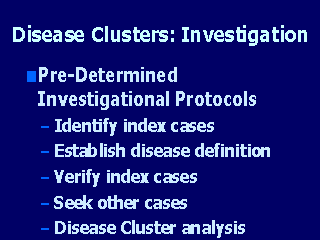|
|
|
|
front |1 |2 |3 |4 |5 |6 |7 |8 |9 |10 |11 |12 |13 |14 |15 |16 |17 |18 |19 |20 |21 |review |
 |
The following are key ingredients to the investigation of disease
clusters. It should be realized that the cluster investigation can be
halted at any point if the criteria for the next step are not fulfilled.
As discussed before, the index cases are often identified by themselves and/or their clinicians. Existing surveillance systems can also detect possible disease clusters. The Investigators need to set up a disease or case definition, with the inclusion of objective criteria (such as laboratory tests) if possible, as well as time and space boundaries. This case definition is applied to all the index cases to verify their case status. Additional cases are sought within the same time and space boundaries. At this point, some comparison with known baseline rates and application of disease cluster statistical analyses should be performed, with and without the index cases. If no significance is found, there can still be compelling reasons for continuing the investigation (e.g. very rare exposure, existing literature, political pressure, etc.), which must be weighed with availability of resources and other considertations. |
|
|
|
|
front |1 |2 |3 |4 |5 |6 |7 |8 |9 |10 |11 |12 |13 |14 |15 |16 |17 |18 |19 |20 |21 |review |